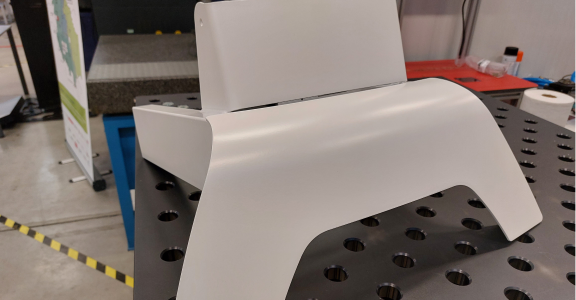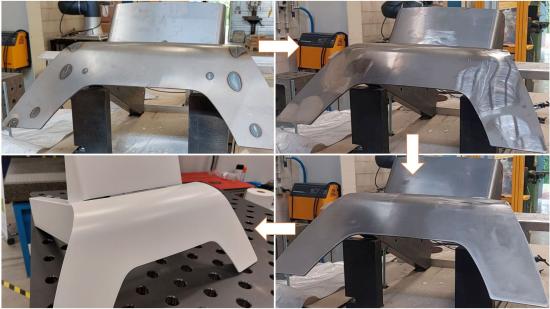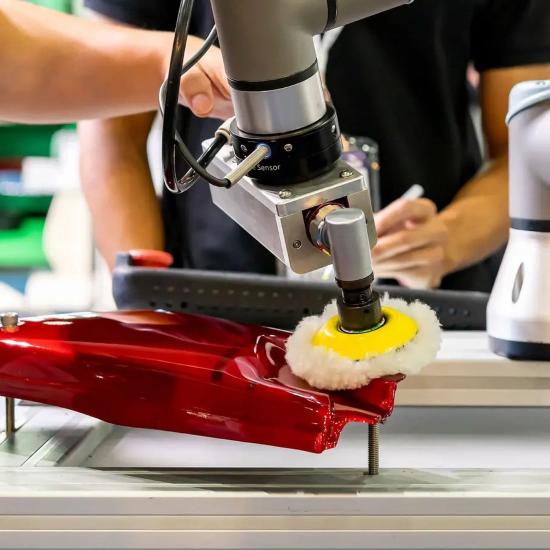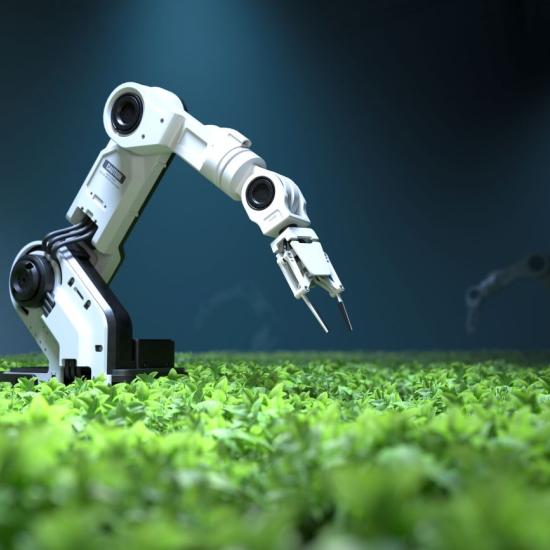Automation can relieve operators of labour-intensive, monotonous tasks such as sanding. However, this is hard to apply to small series and varied products. The COOCK project COBOFIN examines this problem and seeks appropriate solutions based on generic business cases.
The visual requirements for visible surfaces, as in the case of appliances or machines, are constantly increasing. Because welded metal components that require painting often need to have a perfectly even surface, deformations due to welds along the back must be eliminated. At the moment these finishing operations are mainly done by hand, often requiring work that is monotonous, burdensome, dirty, time-consuming and expensive. In addition, many companies are not able to find suitable personnel to perform these tasks. Automation is then necessary to remain competitive.
Finishing with cobots
Commercial automation solutions are available for the finishing work on large series of identical products. However, the suitability of automation for finishing small series of different products is less obvious. Fortunately, technological advances in collaborative robotics (cobots) make it practical to automate finishing operations on small series. The cobot assists the operator by taking over certain repetitive, dirty and difficult tasks, which increases the operator's performance.
The COBOFIN project aims to accelerate the introduction of collaborative robots - as assistants to an experienced operator - for the automated sanding and deburring of small series. To explore the potential for this, a support group was set up within the project to which companies from different sectors can submit cases. By developing these cases, generic knowledge about the use of cobots for finishing parts can be built up.
For example, Provan, which specialises in total metal processing projects varying from tube, profile and sheet processing to complete assemblies, brought a case involving surface improvement after welding on the back of sheet metal. The problem was that the front is visible and must not show any deformations after painting - whether from the welding deformations themselves or by the act of grinding them away. Invisible grinding is a very sensitive process that is difficult to automate - a known problem facing many companies.
Welded workpieces with double curvature
Provan’s welded product is double curved, with radii varying in both directions. This complicates automated finishing and makes it even more difficult not to leave behind any deformations due to excessively deep grinding.
The finishing process consists of two processing steps. First comes grinding, where the thickening of the plate is very carefully ground away with a grinding wheel. Too much pressure or a bad contact angle with the surface can cause grinding marks that are difficult to remove. The second step is sanding with abrasive paper and an orbital sander so that the surface is polished and no grinding marks are visible after painting. The aim of this operation is to make the surface as even as possible. The use of a soft intermediate disc somewhat reduces the chance of damaging the surface during this operation.
Feasibility testing
Feasibility tests were performed to see whether the finishing work could be automated to produce the required quality and to find which tools and settings would be needed for the optimum method. It was examined whether the touch-and-release from the surface could be force-controlled without leaving any traces. Various strategies can be used for this delicate work based on online teaching, which makes programming easier. So far it has been found that grinding with a spline made up of discrete points is the best method. The operator ‘shows’ the cobot where it has to work. This method makes it possible to fine-tune the individual points after an initial grinding on a test piece. The grinding disk is not in operation during the online programming, which makes it difficult to judge whether the contact angle is optimal. During grinding, the cobot will follow the spline in a 'force-compliant' mode, causing the cobot to move 'springily' over the surface and exert a constant force on it. An approach using offline programming may be considered at a later stage.
Furthermore, various parameters – forces, tools, different tool angles and tool speeds – were tested. The grinding disk used in the current manual process is quite aggressive. Because the robot is slightly less sensitive and less responsive, a softer and less aggressive grinding tool was found to work better with the robot.
After painting a test piece, Provan learned whether the quality achieved was already sufficient or whether further optimisation would be needed. The tests have shown that very sensitive grinding and sanding operations on complex surfaces can also be carried out with a cobot and user-friendly online programming. The required quality therefore turned out to be feasible.
Optimising speeds and cell configurations can be part of further research or an industrialization project.
Watch our video with test results: https://vimeo.com/757527933
Would you like to know more? You can find information about the COBOFIN project on the project page. Would you also like to make use of Sirris' knowledge and range of services regarding (cobot) automation of deburring and sanding applications for small series? Then be sure to get in touch!
This initiative receives support from the VLAIO.







